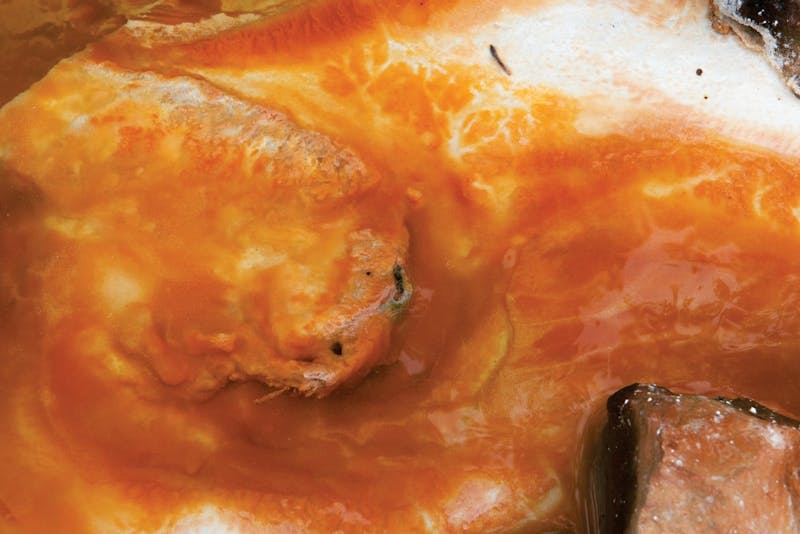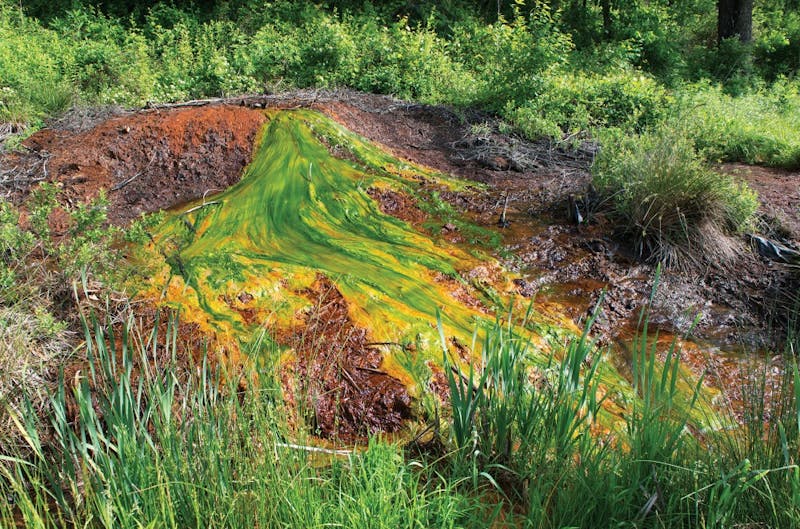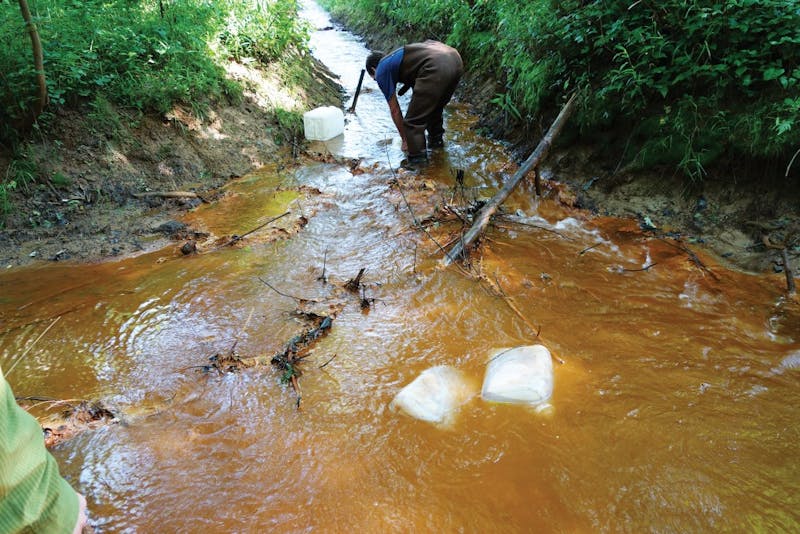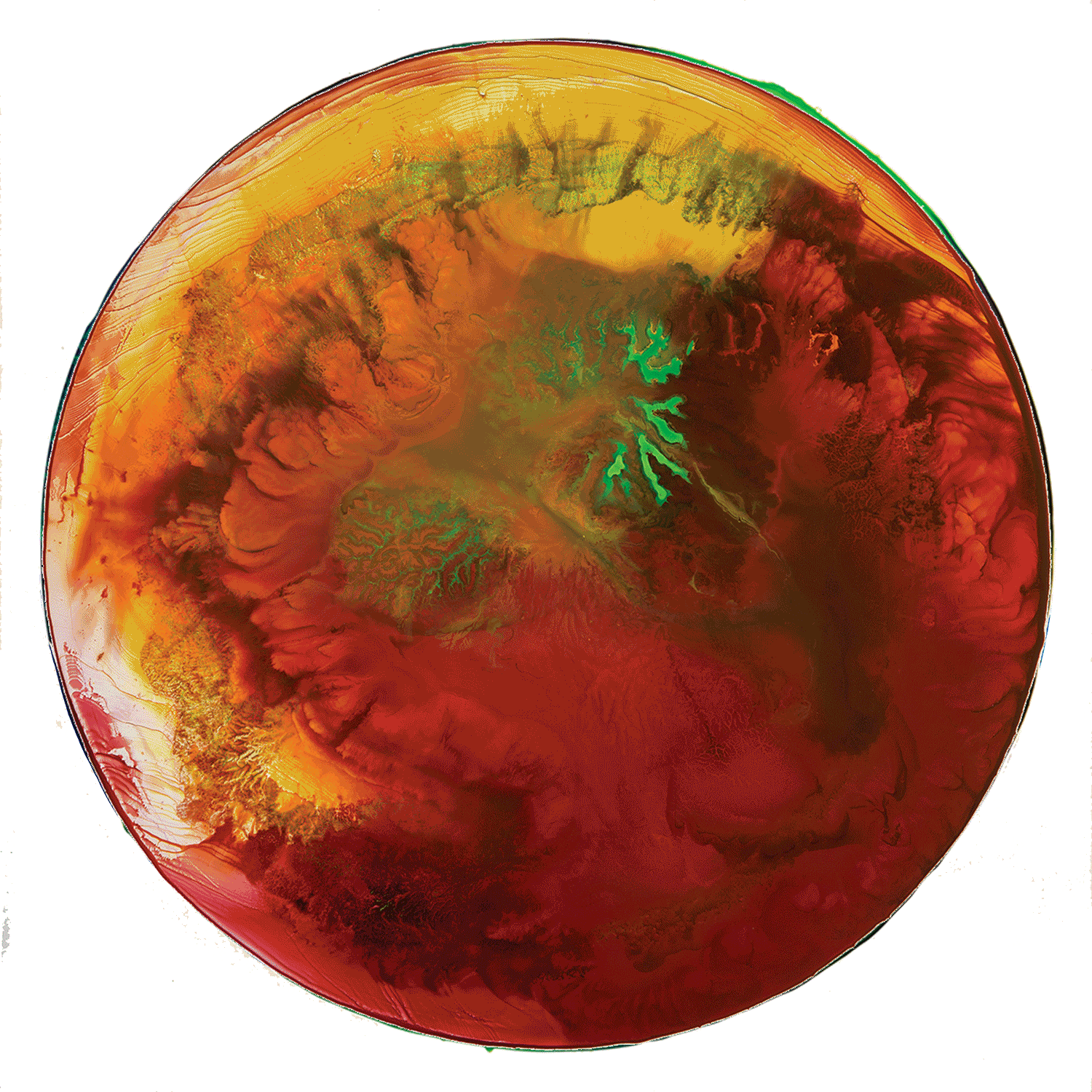

Major sites of pollution from old coal mines are hard to treat, but two OU professors devised a solution
Trace Southeast Ohio’s history of coal mining, and it’s not entirely difficult to understand how the waterways of Appalachia started to run a noticeable, dull rust color. The difficulty is in determining whether that acid mine drainage is a permanent stain on local watersheds.

For decades, the iron-rich, contaminated water has drained from abandoned coal mines, and an Ohio University student could come across it if he or she drove about half an hour north of Athens to Truetown or Corning.
That’s where Sunday Creek watershed coordinator Michelle Shively said it’s easy to spot the two “huge, orange elephants” in the room — two sites where contaminated water resists traditional treatment.
Such treatment has been largely successful in the areas where local watershed groups and state agencies have stepped in, hopeful to reduce the extent of the acid mine drainage.
But Truetown and Corning have found two professors willing to devise alternative solutions for the striking orange color staining Appalachia: turning the contamination into paint, and having that pay for the water treatment process.
Some of the more severe mine discharge sites release 800 to 1,000 gallons of contaminated water per minute, Shively said.
That drainage flows from underground abandoned coal mines into nearby streams and creeks, contaminating drinking water and disrupting the growth of nearby plants and animals, according to the U.S. Environmental Protection Agency.
The treatment necessary to combat larger contamination sites is potentially extensive and complicated, though.
Jen Bowman, an environmental project manager at OU’s Voinovich School, said the mine discharge at Truetown impacts seven miles of Sunday Creek, which flows into the Hocking River.
“This is a particularly difficult discharge to treat due to the volume of water and the high metal load,” she said.
For that reason, Shively said “traditional systems just won’t cut it” when treating such sites.

OU professors Guy Riefler and John Sabraw may have concocted something a little less traditional. The two perfected a process of turning the iron oxide found in the contaminated water into paint pigment. And, if everything goes as planned, the paint would be sold commercially and pay for the project itself.
Shively, who worked on the project with them, said the idea originally grew out of hoping to restore the discharge sites. Riefler, a civil engineering professor, came up with the idea to turn the iron into paint, which Shively called “a radical way of reframing it.”
Acid mine drainage isn’t a recent phenomenon. Many of the abandoned mines in Southeast Ohio date back to the late 1800s and early 1900s, Bowman said, and they released contaminated water into streams throughout the 20th century.
By 2001, about 341 miles of streams in Ohio were impacted by the contamination, according to data from the Voinovich School, which evaluates water quality. The school’s researchers tested contaminated streams in Southeast Ohio in 2010, and found that out of the 175 miles they tested, only 47 qualified as a healthy habitat for animals and plants.
“Abandoned mines have caused stream pollution for many decades,” Bowman, who conducts water quality research for the school, said. “This is a long-term problem given the vast nature and extent of the underground mines.”
Allan Withem has experienced acid mine drainage firsthand — he played in the orange, contaminated streams as a child.
“There were streams right by my house, and we walked over every day,” he said. “It was a place for kids to be. We didn’t know about the problem.”
That problem, exactly, involves a chemical reaction: Coal mines contain the mineral pyrite, which reacts with water and air to form sulfuric acid and iron. The sulfuric acid makes the water highly acidic, and the iron gives the water its orange color. Over time, the water drains into nearby streams, creating acid mine drainage.
Withem grew up near the Snow Fork area of Monday Creek, another Southeast Ohio watershed damaged by acid mine drainage. He said he didn’t realize how bad the streams were until he got older.

Photo by Louise O’Rourke
Provided via John Sabraw
Shively said the acidic water coming out of mines is around 3 to 4 pH. For context, orange juice has a pH of about 4 and normal water has a pH of 7.
The restoration projects to combat the drainage usually involve running stream water through lime material, which separates the metals in the water and reduces its acidity, Shively said.
For example, one method involves constructing a “leach bed,” where water runs across a bed of limestone gravel. The toxic metals are separated and trapped in the bed, and the clean water returns to the stream.
Nearly $30 million has been spent by local, state and federal governments, local watershed groups and the university to construct 66 stream reclamation projects in Ohio, Bowman said.
The watershed groups are part of Rural Action, a nonprofit community development organization based in Athens County.
“All were formed by citizens who wanted something done about their creeks,” Shively said. “They’ve had their water run orange for years.”
The treatment is proving successful. Last year, 172 out of 183 miles tested by the Voinovich School had acceptable water quality, or at least 6.5 pH. Now, attention is needed at the high discharge sites in Truetown and Corning, among others. The sites have a very low pH and high concentration of iron.

Photo by Louise O’Rourke
Provided via John Sabraw
“For a limestone leach bed, you’d have to have them on such a massive scale,“ Shively said. “It’s not feasible.”
What Riefler and Sabraw have proposed, though, may be a feasible alternative.
To develop the paint pigment, Riefler consulted Sabraw, a professor of art and chair of OU’s painting and drawing program. Sabraw said he’s always been an environmental activist interested in incorporating science into his art.
To create the paint pigment, the iron oxide is separated from the water and dried out, Sabraw said, producing different shades of orange, yellow and black. Over the past few years, Sabraw has worked to refine the process of making the pigment, which he used in a series of paintings called “Chroma.” That series featured abstract layers of paint on aluminum panels.
Shively said Sabraw’s art has received more attention than the watershed groups’ scientific work.
“It’s really cool how art reaches people so effectively and significantly,” she said. “The art speaks to people in a different way than we can through science.”
The two professors hope to implement their idea of producing paint from acid mine drainage on a larger level through a “pilot scale” plant in Corning, which would treat the contaminated water and produce iron oxide for the paint, combining their collective interest in art and science. If the paint sells, it could fund the cleanup process.
“If we could build this plant, it would give precise information to the state of Ohio or private companies who can use the process to clean up many kinds of waste in the same manner,” Sabraw said.
Sabraw consulted undergraduate students in his “Science and Art” studio art class, who helped create the proposed design for the plant.
“The art speaks to people in a different way than we can through science.” Michelle Shively, Sunday Creek watershed coordinator
Samantha Slone, an OU alumna who graduated last spring with a bachelor’s degree in studio art, worked with Sabraw on the project and in his class.
“Designing the treatment plant was a blast, because we all had to work with both aesthetic and functionality in mind, as well as how this building would fit into the community,” Slone said.
Slone said she and the other students in the class tried to make the inner-workings of the treatment process more visible through their design.
An obstacle in building the plant, though, is funding. Their team is in the process of applying for grants from the university and other sources.
“I truly hope the budget for this process comes through,” Slone said. “It would be incredible to see our work come to fruition, but more importantly, the community needs this. All life in that stream is decimated.”
Withem said he hopes the efforts to stop acid mine drainage succeed.
“I hope it gets cleaned up. They’ve made big improvements, but some places are still really bad,” Withem, a computer specialist for Rural Action, said. “There’s nothing that they can do about some.”
